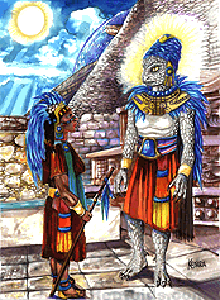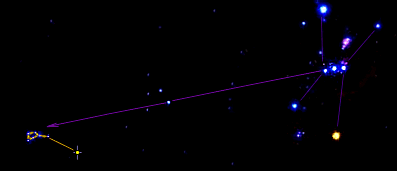
Quetzalcoatl was identified to Atlantis Egypt, Sumer, then later to Mesoamerica and Peru as Quetzacoatl.
Quetzalcoatl ("feathered snake") is the Aztec name for the Feathered-Serpent deity of ancient Mesoamerica, one of the main gods of many Mexican and northern Central American civilizations.
The name "Quetzalcoatl" literally means quetzal-bird snake or serpent with feathers of the Quetzal (which implies something divine or precious) in the Nahuatl language. The meaning of his local name in other Mesoamerican languages is similar. The Maya knew him as Kukulkán; the Quiché as Gukumatz.
The Feathered Serpent deity was important in art and religion in most of Mesoamerica for close to 2,000 years, from the Pre-Classic era until the Spanish Conquest. Civilizations worshiping the Feathered Serpent included the Olmec, the Mixtec, the Toltec, the Aztec, and the Maya.
The worship of Quetzalcoatl sometimes included human sacrifices, although in other traditions Quetzalcoatl was said to oppose human sacrifice.
Mesoamerican priests and kings would sometimes take the name of a deity they were associated with, so Quetzalcoatl and Kukulcan are also the names of historical persons.
One noted Post-Classic Toltec ruler was named Quetzalcoatl; he may be the same individual as the Kukulcan who invaded Yucatan at about the same time. The Mixtec also recorded a ruler named for the Feathered Serpent. In the 10th century a ruler closely associated with Quetzalcoatl ruled the Toltecs; his name was Topiltzin Ce Acatl Quetzalcoatl. This ruler was said to be the son of either the great Chichimeca warror, Mixcoatl and the Colhuacano woman Chimalman, or of their descendant.
The Toltecs had a dualistic belief system. Quetzalcoatl's opposite was Tezcatlipoca, who supposedly sent Quetzalcoatl into exile. Alternatively, he left willingly on a raft of snakes, promising to return.
When the Aztecs adopted the culture of the Toltecs, they made twin gods of Tezcatlipoca and Quetalcoat, opposite and equal; Quetalcoatl was also called White Tezcatlipoca, to contrast him to the black Tezcatlipoca. Together, they created the world; Tezcatlipoca lost his foot in that process.
The Aztec Emperor Moctezuma II initially believed the landing of Cortés in 1519 was Quetzalcoatl's return. Cortes played off this belief to aid in his conquest of Mexico.
The exact significance and attributes of Quetzalcoatl varied somewhat between civilizations and through history. Quetzalcoatl was often considered the god of the morning star and his twin brother, Xolotl was the evening star (Venus). As the morning star he was known under the title Tlahuizcalpantecuhtli, which means literaly "the lord of the star of the dawn". He was known as the inventor of books and the calendar, the giver of maize corn to mankind, and sometime as a symbol of death and resurrection. Quetzalcoatl was also the patron of the priests and the title of the Aztec high priest.
Most Mesoamerican beliefs included cycles of worlds. Usually, our current time was considered the fifth world, the previous four having been destroyed by flood, fire and the like. Quetzalcoatl allegedly went to Mictlan, the underworld, and created fifth world-mankind from the bones of the previous races (with the help of Cihuacoatl), using his own blood to imbue the bones with new life.
His birth, along with his twin Xolotl, was unusual; it was a virgin birth, born to the goddess Coatlicue. Alternatively, he was a son of Xochiquetzal and Mixcoatl.
One Aztec story claims Quetzalcoatl was seduced by Tezcatlipoca but then burned himself to death out of remorse. His heart became the morning star (see Tlahuizcalpantecuhtli).
Quetzalcoatl was a god of such importance and power that nearly no aspect of everyday life seemed to go untouched by him. Secondly, as a historical figure, his actions would nor could not be contained by the History and thus eventually evolved into myth. And as a legend, he would signal the end of mortal kingship. An interesting phenomena that distinguished Quetzalcoatl is that despite the fact he is not the most powerful of gods within the Mesoamerican pantheon, or one of the eldest, he is nonetheless an integral part of the system. This was partially accomplished by his ability to integrate himself so securely to attributes of his fellow brethren, to such an extent that it is virtually impossible to tell if Quetzalcoatl was the true originator or vise versa. Hence, to establish a single definitive personality to a god is extremely difficult.
Lastly, it must be kept in mind that despite Quetzalcoatl being an Aztec name, the cultures preceding them had their name for him as well, and applying their own unique attributes to him. Consequently, Quetzalcoatl is related to many names and incarnations, and seems to play a prominent role in a pantheon of virtually all the other Mesoamerican deities. Quetzalcoatl himself goes by the names of Gukumatz, Nine Wind, and Kukulcan among others. These are the most common names found in the general Aztec and Mayan cultures, with Quetzalcoatl maintaining a host of avatars with whom he is intimately connected with or represented by. There are also certain gods that Quetzalcoatl is involved with most of the time as well, such as Xolotl, Tlaloc, Xipe, and Tezcatlipoca. These "upper level" gods are either contrary, complimentary, or both at the same time towards Quetzalcoatl, creating a sense of duality around these myths.
Duality itself runs rampant in myth, as well as being found in the astronomical/cosmological associations between Quetzalcoatl and the heavens and stars. Questions run the gamut from his morning star associations (as Venus) to the possibilities of his connection with Mercury. Ultimately it is this symbolism that runs through the myth and its astrological and cosmological incarnations which raise the questions and hint at Quetzalcoatl's power and pervasiveness.


